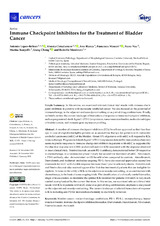Mostrar el registro sencillo del ítem
Immune Checkpoint Inhibitors for the Treatment of Bladder Cancer
| dc.contributor.author | López-Beltrán, Antonio | |
| dc.contributor.author | Cimadamore, Alessia | |
| dc.contributor.author | Blanca, Ana | |
| dc.contributor.author | Massari, Francesco | |
| dc.contributor.author | Vau, Nuno | |
| dc.contributor.author | Scarpelli, Marina | |
| dc.contributor.author | Cheng, Liang | |
| dc.contributor.author | Montironi, Rodolfo | |
| dc.date.accessioned | 2021-01-08T12:34:46Z | |
| dc.date.available | 2021-01-08T12:34:46Z | |
| dc.date.issued | 2021 | |
| dc.identifier.uri | http://hdl.handle.net/10396/20946 | |
| dc.description.abstract | A number of immune checkpoint inhibitors (ICIs) have been approved as first-line therapy in case of cisplatin-ineligible patients or as second-line therapy for patients with metastatic urothelial carcinoma (mUC) of the bladder. About 30% of patients with mUC will respond to ICIs immunotherapy. Programmed death-ligand 1 (PD-L1) expression detected by immunohistochemistry seems to predict response to immune checkpoint inhibitors in patients with mUC as supported by the objective response rate (ORR) and overall survival (OS) associated with the response observed in most clinical trials. Pembrolizumab, an anti-PD-1 antibody, demonstrated better OS respective to chemotherapy in a randomized phase 3 study for second-line treatment of mUC. Nivolumab, a PD-1 antibody, also demonstrated an OS benefit when compared to controls. Atezolizumab, Durvalumab, and Avelumab antibodies targeting PD-L1 have also received approval as second-line treatments for mUC with durable response for more than 1 year in selected patients. Atezolizumab and Pembrolizumab also received approval for first-line treatment of patients that are ineligible for cisplatin. A focus on the utility of ICIs in the adjuvant or neoadjuvant setting, or as combination with chemotherapy, is the basis of some ongoing trials. The identification of a clinically useful biomarker, single or in association, to determine the optimal ICIs treatment for patients with mUC is very much needed as emphasized by the current literature. In this review, we examined relevant clinical trial results with ICIs in patients with mUC alone or as part of drug combinations; emphasis is also placed on the adjuvant and neoadjuvant setting. The current landscape of selected biomarkers of response to ICIs including anti-PD-L1 immunohistochemistry is also briefly reviewed. | es_ES |
| dc.format.mimetype | application/pdf | es_ES |
| dc.language.iso | eng | es_ES |
| dc.publisher | MDPI | es_ES |
| dc.rights | https://creativecommons.org/licenses/by/4.0/ | es_ES |
| dc.source | Cancers 13(1), 131 (2021) | es_ES |
| dc.subject | Bladder cancer | es_ES |
| dc.subject | Variant histology | es_ES |
| dc.subject | Urothelium | es_ES |
| dc.subject | PD-1 | es_ES |
| dc.subject | PD-L1 | es_ES |
| dc.subject | Immunotherapy | es_ES |
| dc.subject | Tumor mutation burden | es_ES |
| dc.subject | Immune checkpoint inhibitor | es_ES |
| dc.subject | Biomarker | es_ES |
| dc.subject | Durvalumab | es_ES |
| dc.subject | Atezolizumab | es_ES |
| dc.subject | Nivolumab | es_ES |
| dc.subject | Pembrolizumab | es_ES |
| dc.subject | Avelumab | es_ES |
| dc.title | Immune Checkpoint Inhibitors for the Treatment of Bladder Cancer | es_ES |
| dc.type | info:eu-repo/semantics/article | es_ES |
| dc.relation.publisherversion | http://dx.doi.org/10.3390/cancers13010131 | es_ES |
| dc.rights.accessRights | info:eu-repo/semantics/openAccess | es_ES |

